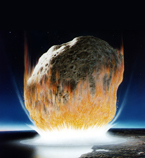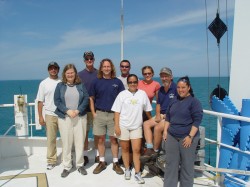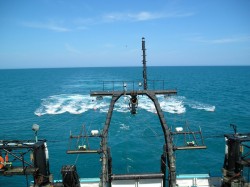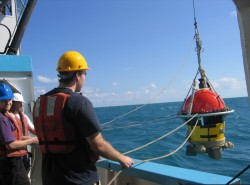Seismic Images Show Dinosaur-Killing Meteor Made Bigger Splash
January 1, 2008

The most detailed three-dimensional seismic images yet of the Chicxulub crater, a mostly submerged and buried impact crater on the Mexico coast, may modify a theory explaining the extinction of 70 percent of life on Earth 65 million years ago.
The Chicxulub crater was formed when an asteroid struck on the coast of the Yucatan Peninsula. Most scientists agree the impact played a major role in the “KT Extinction Event” that caused the extinction of most life on Earth, including the dinosaurs.
According to Sean Gulick, a research scientist at the Institute for Geophysics at The University of Texas at Austin’s Jackson School of Geosciences and principal investigator for the project, the new images reveal the asteroid landed in deeper water than previously assumed and therefore released about 6.5 times more water vapor into the atmosphere.
The impact site also contained sulfur-rich sediments called evaporites, which would have reacted with water vapor to produce sulfate aerosols. According to Gulick, an increase in the atmospheric concentration of the compounds could have made the impact deadlier in two ways: by altering climate (sulfate aerosols in the upper atmosphere can have a cooling effect) and by generating acid rain (water vapor can help to flush the lower atmosphere of sulfate aerosols, causing acid rain). Earlier studies had suggested both effects might result from the impact, but to a lesser degree.

“The greater amount of water vapor and consequent potential increase in sulfate aerosols needs to be taken into account for models of extinction mechanisms,” says Gulick.
The results appear in the February 2008 print edition of the journal Nature Geosciences.
Mechanisms that have been proposed to link the asteroid impact to extinctions include: a few hours of intense heat immediately following the impact caused by ejected material falling back through the atmosphere, aerosol clouds blocking out sunlight and killing off plants followed by a domino effect of plant eaters and eaters of plant eaters, global firestorms, unprecedented earthquakes, and megatsunami waves hundreds of meters tall.
An increase in acid rain might help explain why reef and surface dwelling ocean creatures were affected along with large vertebrates on land and in the sea. As it fell on the water, acid rain could have turned the oceans more acidic. There is some evidence that marine organisms more resistant to a range of pH survived while those more sensitive did not.
Gulick says the mass extinction event was probably not caused by just one mechanism, but rather a combination of environmental changes acting on different time scales, in different locations. For example, many large land animals might have been baked to death within hours or days of the impact as ejected material fell from the sky, heating the atmosphere and setting off firestorms. More gradual changes in climate and acidity might have had a larger impact in the oceans.
Changing Trajectory

To compile the new seismic image, the team placed 28 ocean bottom seismometers in the Gulf of Mexico and 87 land based seismometers on the Yucatan Peninsula. They then used the National Science Foundation Research Vessel Maurice Ewing to tow an airgun array and a hydrophone streamer along 1800 kilometers of transects crossing over the crater. When the airguns fired, sound traveled into the subsurface and reflected and refracted back up to the seismometers and hydrophones. These data were combined to produce the most detailed three-dimensional image of the crater yet.
Earlier images of the crater’s structure in the subsurface were based on gravity measurements and less extensive seismic surveys. Based on those images, scientists had speculated that the asteroid came in from the southwest or southeast (depending on varying interpretations) at either a low or high angle (again depending on the interpretation). They also estimated that before impact, the site was flat and sitting in less than 100 meters of water.
Gulick and his collaborators originally set out to learn more about the trajectory of the asteroid. Instead, they discovered that the target site was quite different from original assumptions. According to the new interpretation, the impact site on the continental shelf had originally sloped from about 100 meters depth to over 1200 meters. That also meant that it was under much more water.
“We discovered that the shallow structure of the crater was determined much more by what the impact site was like before impact than by the trajectory of the impactor,” says Gulick.
If scientists can determine the trajectory, it will tell them where to look for the biggest environmental consequences of impact, because most of the hazardous, shock-heated and fast moving material would have been thrown out of the crater downrange from the impact.

Researchers at Imperial College in London are already using computer models to search for possible signatures in impact craters that could indicate trajectory regardless of the initial surface conditions at the impact site.
“As someone who simulates impact events using computers, this work provides valuable new constraints on both the pre-impact target structure and the final geometry of the cratered crust at Chicxulub,” says Gareth Collins, a research fellow at Imperial College.
Gulick and his collaborators have proposed a project to drill into the crater to help answer questions about the asteroid’s trajectory, the energy released by the impact, and how local life forms changed just before and after impact. Gulick says one theory is that the impact would have created hydrothermal vent systems that could support exotic forms of life. He’s eager to find out if there is evidence of such vents at the site. He also hopes this work will help scientists better understand impacts on bodies throughout the solar system.
Collaborators on the project included Gail Christeson at the Institute for Geophysics, Penny Barton at the University of Cambridge, Joanna Morgan and Mike Warner at Imperial College, and several graduate students.
by Marc Airhart
For more information about research at the Jackson School, contact J.B. Bird at jbird@jsg.utexas.edu, 512-232-9623.
